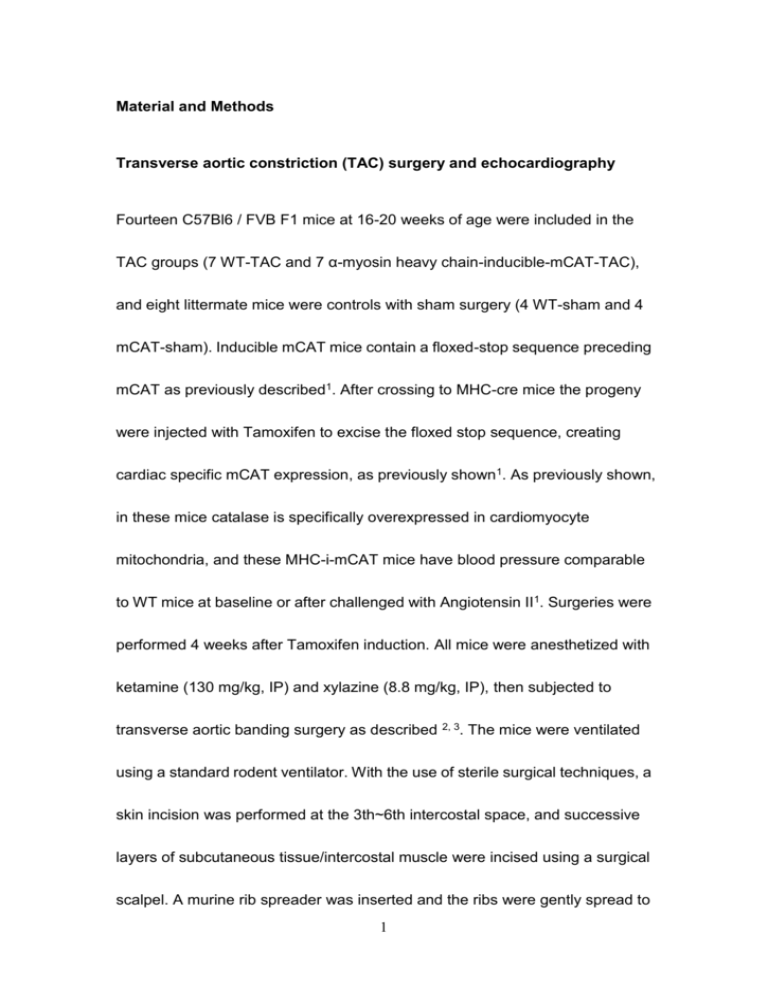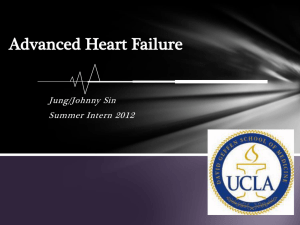Material and Methods
advertisement

Material and Methods
Transverse aortic constriction (TAC) surgery and echocardiography
Fourteen C57Bl6 / FVB F1 mice at 16-20 weeks of age were included in the
TAC groups (7 WT-TAC and 7 α-myosin heavy chain-inducible-mCAT-TAC),
and eight littermate mice were controls with sham surgery (4 WT-sham and 4
mCAT-sham). Inducible mCAT mice contain a floxed-stop sequence preceding
mCAT as previously described1. After crossing to MHC-cre mice the progeny
were injected with Tamoxifen to excise the floxed stop sequence, creating
cardiac specific mCAT expression, as previously shown1. As previously shown,
in these mice catalase is specifically overexpressed in cardiomyocyte
mitochondria, and these MHC-i-mCAT mice have blood pressure comparable
to WT mice at baseline or after challenged with Angiotensin II1. Surgeries were
performed 4 weeks after Tamoxifen induction. All mice were anesthetized with
ketamine (130 mg/kg, IP) and xylazine (8.8 mg/kg, IP), then subjected to
transverse aortic banding surgery as described
2, 3.
The mice were ventilated
using a standard rodent ventilator. With the use of sterile surgical techniques, a
skin incision was performed at the 3th~6th intercostal space, and successive
layers of subcutaneous tissue/intercostal muscle were incised using a surgical
scalpel. A murine rib spreader was inserted and the ribs were gently spread to
1
allow access to the thoracic cavity. The aortic arch was isolated from the
pulmonary artery and a sterile ligature was passed around it. A blunted 26
gauge needle was placed on top of the aorta and ligation was tied around the
needle. Then the needle was carefully removed. The rodent rib spreader was
removed, the lungs were inflated by the ventilator and the chest/skin
musculature was closed in successive layers with sutures. Animals were
closely monitored until full recovery from anesthesia. Echocardiography was
performed at baseline, at 1 week after TAC and at the end of experiments using
a Siemens Acuson CV-70 equipped with 13 MHz probe, as described 4. Briefly,
isoflurane 0.5% mixed with O2 was used to provide adequate sedation but
minimal cardiac suppression during echocardiography. M-mode, conventional
and Tissue Doppler echocardiography, and functional calculations were
performed according to American Society of Echocardiography guidelines. An
increase in MPI (calculated as the ratio of the sum of isovolemic contraction and
relaxation time to LV ejection time) indicated that a greater fraction of systole
was spent to cope with the pressure changes during isovolemic phases, and
has been shown to reflect both LV systolic and diastolic dysfunction.
2
Quantitative PCR and pathology
The quantitation of relative gene expression was performed using Taqman
Gene Expression Assays and an Applied Biosystems 7900 thermocycler. The
genes include: ANP (Mm01255747), BNP (Mm 00435304), collagen 1a2 (Mm
00483937) and PGC1-α (Mm00731216). All expression assays were
normalized to 18S RNA. Quantitative histopathology was performed as
previously described 4. In brief, coronal slices of heart tissue were
paraffin-embedded, sectioned, and subjected to Masson Trichrome staining.
The percentage of blue-staining fibrotic tissue was measured relative to the
total cross-sectional area of the ventricles.
Purification of cardiac mitochondrial fractions
Three animals from each experimental group were processed for mitochondrial
proteomics analysis. Mitochondrial isolation was performed as previously
described 5. Briefly, cardiac ventricular tissues were homogenized in
mitochondrial isolation buffer (250 mM sucrose, 1 mM EGTA, 10 mM HEPES,
10 mM Tris-HCl pH7.4), then the lysates were centrifuged at 800 x g for 10
3
minutes. The supernatants were further centrifuged at 4,000 g for 30 minutes
at 4 ºC. The crude mitochondrial pellets were then resuspended in 19% Percoll
solution in isolation buffer and slowly layered on top of a preformed step Percoll
gradient, 30 and 60% (v/v), respectively. After centrifugation at 10,000 x g for
20 minutes, purified mitochondria were retrieved at the interface between two
layers. All procedures were performed at 4 °C. The purity of mitochondrial
extract was examined using Citrate synthase activity assay and Western blots
for the mitochondrial protein Prohibitin (Biomeda Corp, 1:1000) and the
cytosolic protein GAPDH (Millipore,1:10,000), as previously described.
Sample Preparation and Analysis by Mass Spectrometry
Mitochondrial fractions were solubilized with Rapigest (Waters Corporation,
Milford, MA) to a final concentration of 0.1% and boiled for 5 min. The samples
were then treated with 5 mM DTT at 60 °C for 30 minutes to reduce disulfide
bonds. The free sulfhydryls were alkylated with treatment of 15 mM
iodoacetamide at room temperature for 30 minutes. Trypsin was added to a
final concentration of 1:100 (µg trypsin: µg protein) and the sample digested at
4
37 °C for 2 hours. The trypsin activity was halted and rapigest was hydrolyzed
with the addition of HCl to a final concentration of 200 mM and incubation at 37
°C for 30 minutes. The samples were centrifuged for 10 minutes at 20,000 g
and the supernatant saved. The digested samples were analyzed by
LC-MS/MS.
A Waters nanoAcquity LC system was used. Peptides were separated at a flow
rate of 250 nl/min over a homemade 35 cm long, 75 μm inner diameter, fused
silica capillary column packed with Jupiter Proteo 90A C-12 resin
(Phenomonex). The mobile phase consisted of buffer A (water, 0.1% formic
acid) and buffer B (acetonitrile, 0.1% formic acid). The gradient used was: 9%
buffer B to 36% buffer B for 180 minutes, followed by a 5 minute wash with 80%
buffer B and a 15 minute re-equilibration at 9% buffer B. Peptides were ionized
by electrospray. The mass spectrometer used was a Thermo Scientific LTQ-FT
Ultra. The scan cycle used consisted of one full scan in the FTICR (400 – 1,400
m/z, 50,000 FWHM resolution at 400 m/z, profile mode) followed by five data
dependent MS/MS scans of the five most intense ions in the ion trap. Dynamic
exclusion was used with a repeat count of one and an exclusion time of 30
seconds.
5
Analysis of MS Data and statistical analysis
High resolution MS data was processed by Bullseye 6 to optimize precursor
mass information. MS/MS spectra were searched by SEQUEST (version 27)
7
against a mouse IPI database (3/25/09). The search was done with semi-tryptic
specificity, a static mass modification of 57.021 on cysteines and a precursor
mass tolerance of ±10 ppm. Peptide spectrum match false discovery rates
were determined by the Percolator algorithm 8 with a threshold of 0.01.
Parsimonious protein inference was determined using the IDPicker algorithm 9.
Chromatographic alignment and peptide peak areas were determined by
CRAWDAD (4). This workflow is shown in Figure 1.
In order to determine statistically significant changes of proteins between
experimental groups, we used a linear model of peptide abundance to calculate
fold changes of proteins between experimental groups in the same manner as
a two-sample t-test using the R/Bioconductor software 10. For the cases where
a protein consisted of more than one peptide, the linear model was modified to
account for the multiple peptides by using a blocking factor. The linear model
6
output gave p-values that were adjusted for multiplicity with the Bioconductor
package q-value 11, which allows for selecting statistically significant genes
while controlling the estimated false discovery rate. Since our focus was on
mitochondria proteins, we only looked at those proteins we measured that were
in the list of 1334 proteins of MITOP.2 12 (http://www.mitop.de:8080/mitop2/)
In order to determine groups of related proteins, we used biological process
category analysis via the cumulative hypergeometric distribution method of
determining enhanced Gene Ontology categories
13
using the Bioconductor
package topGO 10, 14. This approach uses our lists of statistically significant
genes and identifies Gene Ontology categories by evidence of
over-representation of significant genes. We employed the topGO classic and
weight method. The weight method is a combination of the classic method
and the elimination method. In the classic method each Gene Ontology
category is treated as independent, even if there is a large overlap of member
genes. In the elimination method, genes that are significant in lower level GO
categories are removed from higher levels. The topGO weight method genes
are weighted depending on their scores in neighboring nodes, thereby better
identifying and removing local dependencies between GO categories. The
7
weight method has the advantage of reducing the false-positive rate 11, while at
the same time not missing many truly enriched categories.
Western blot
Antibodies used for the Western blots were anti Acadvl, anti Aco2, anti Prdx3,
anti elongation factor Tu (Tufm) ( all from Santa Cruz Biotechnology,
SC-74898, SC-130677, SC-23973, SC-12991, respectively, all at 1:1,000), anti
Hk1 (Cell Signaling, 1:1,000), anti Opa1 (Novus Biologicals, NB110-55290,
1:1,000) and Donkey anti-rabbit secondary antibody (Thermo Scientific,
1:10,000 dilution).
Statistical Analysis for other data
Data in figure 1 and 2 were presented as means ± SEM. One-way or two-way
ANOVA was used to compare differences among multiple groups, followed by
post-hoc test for significance. P<0.05 was considered significant.
8
References:
1.
Dai DF, Johnson SC, Villarin JJ, Chin MT, Nieves-Cintron M, Chen T et al.
Mitochondrial Oxidative Stress Mediates Angiotensin II-Induced Cardiac
Hypertrophy and G{alpha}q Overexpression-Induced Heart Failure. Circ Res
2.
2011;108:837-846.
Kim Y, Phan D, van Rooij E, Wang DZ, McAnally J, Qi X et al. The
MEF2D transcription factor mediates stress-dependent cardiac remodeling in
3.
mice. J Clin Invest 2008;118:124-132.
Tarnavski O, McMullen JR, Schinke M, Nie Q, Kong S, Izumo S. Mouse
cardiac surgery: comprehensive techniques for the generation of mouse
models of human diseases and their application for genomic studies. Physiol
4.
Genomics 2004;16:349-360.
Dai DF, Santana LF, Vermulst M, Tomazela DM, Emond MJ, MacCoss MJ
et al. Overexpression of catalase targeted to mitochondria attenuates murine
5.
cardiac aging. Circulation 2009;119:2789-2797.
Zhang J, Li X, Mueller M, Wang Y, Zong C, Deng N et al. Systematic
characterization of the murine mitochondrial proteome using functionally
6.
validated cardiac mitochondria. Proteomics 2008;8:1564-1575.
Hsieh EJ, Hoopmann MR, MacLean B, MacCoss MJ. Comparison of database
search strategies for high precursor mass accuracy MS/MS data. J Proteome
7.
8.
9.
Res 2010;9:1138-1143.
Ducret A, Van Oostveen I, Eng JK, Yates JR, 3rd, Aebersold R. High
throughput protein characterization by automated reverse-phase
chromatography/electrospray tandem mass spectrometry. Protein Sci
1998;7:706-719.
Kall L, Canterbury JD, Weston J, Noble WS, MacCoss MJ. Semi-supervised
learning for peptide identification from shotgun proteomics datasets. Nat
Methods 2007;4:923-925.
Zhang B, Chambers MC, Tabb DL. Proteomic parsimony through bipartite
graph analysis improves accuracy and transparency. J Proteome Res
10.
2007;6:3549-3557.
Gentleman RC, Carey VJ, Bates DM, Bolstad B, Dettling M, Dudoit S et al.
Bioconductor: open software development for computational biology and
11.
bioinformatics. Genome Biol 2004;5:R80.
Tusher VG, Tibshirani R, Chu G. Significance analysis of microarrays applied
to the ionizing radiation response. Proc Natl Acad Sci U S A
2001;98:5116-5121.
9
12.
Elstner M, Andreoli C, Klopstock T, Meitinger T, Prokisch H. The
13.
mitochondrial proteome database: MitoP2. Methods Enzymol 2009;457:3-20.
Camon E, Magrane M, Barrell D, Binns D, Fleischmann W, Kersey P et al.
The Gene Ontology Annotation (GOA) project: implementation of GO in
14.
SWISS-PROT, TrEMBL, and InterPro. Genome Res 2003;13:662-672.
Alexa A, Rahnenfuhrer J, Lengauer T. Improved scoring of functional groups
from gene expression data by decorrelating GO graph structure.
Bioinformatics 2006;22:1600-1607.
10







